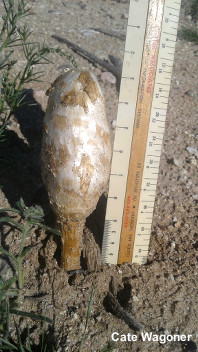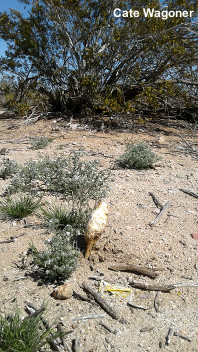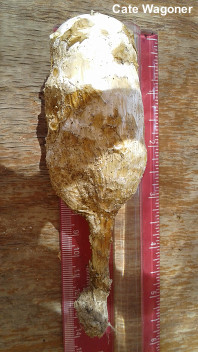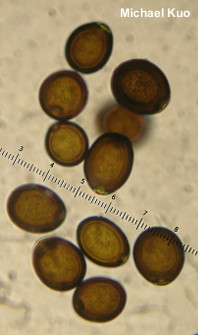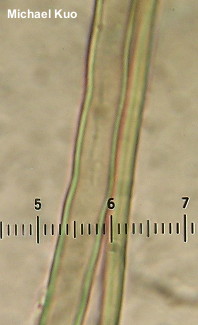| Major Groups > Gilled Mushrooms > Dark-Spored > Coprinoid/Puffballs/Oddballs > Podaxis pistillaris |

|
Podaxis pistillaris [ Basidiomycota > Agaricales > Agaricaceae > Podaxis . . . ] by Michael Kuo Podaxis pistillaris is found in the deserts of western North America and in Mexico, looking for all the world like an improbable shaggy mane (Coprinus comatus) that somehow managed to survive in arid conditions. But close examination reveals a key difference: the interior is not composed of crowded, deliquescing gills; instead, it consists of poorly formed, contorted, gill-like plates that eventually erode into a very dark brown or nearly black spore powder. In fact it turns out that Podaxis pistillaris is not all that closely related to Coprinus comatus, despite superficial appearances; DNA studies have placed it near lepiotoid mushrooms in the genera Leucoagaricus and Macrolepiota (see for example Vellinga and collaborators, 2011). A study of Podaxis collections (Conlon and collaborators, 2016) supported the idea that there are several species of Podaxis in need of clarification, and that spore morphology and ecology may be useful in predicting speciation. Only three North American specimens were studied, however; the remaining material was African. The North American collections formed a group that was clearly separated from the African groups—but extensive study of specimens world-wide, along with much more thorough sampling of Podaxis on our continent, will be required before we can know whether our North American version of Podaxis pistillaris is actually the same as the original species, which was named from India by Linnaeus in 1771. Podaxis longii and several other species are similar; see the key to coprinoid mushrooms (couplets 49-51) for help sorting them out. Thanks to Cate Wagoner for collecting, documenting, and preserving Podaxis pistillaris for study; her collection is deposited in The Herbarium of Michael Kuo. Description: Ecology: Presumably saprobic; growing alone or scattered in arid, desert settings—including wasteland, fields, and urban locations; fall through spring; fairly common in the deserts of the southwest and California. The illustrated and described collection is from southern California. Cap: 4–8 cm high and 2–4 cm across at maturity; oval when young, becoming more or less cylindric, with a rounded apex; shaggy to scaly; dry; white to whitish or pale brownish; the margin tucked under and attached to the stem; the outer layer shredding in old age to expose the mass of spore dust inside. Interior: Composed of vaguely gill-like, contorted plates; at first whitish but soon brownish and eventually turning into dark brown to nearly black powder. Stem: Extending into the cap; 4–10 cm long below the cap; up to 1 cm thick; more or less equal above a base that is usually buried and rooted in the sand; extremely tough and woody; coarsely fibrillose to scaly; whitish to brownish; without a ring. Flesh: Tough; whitish. Odor and Taste: Odor not distinctive. Spore Print: Not obtainable as a "spore print," but mature specimens shed very dark brown to nearly black spore powder. Microscopic Features: Spores 13–19 x 10–13 µm (but often reported as slightly smaller, around 10–15 x 9–12 µm); broadly ellipsoid; with a large pore at one end measuring 2–5 µm across; with a very thick double wall; smooth; brown in KOH. Capillitial threads 3–8 µm wide; occasionally septate; smooth; yellowish-walled in KOH; walls 1 µm thick; sometimes becoming coiled. REFERENCES: (Linnaeus, 1771) Fries, 1829. (Saccardo, 1888; Morse, 1933; Smith, Smith & Weber, 1981; Arora, 1986; States, 1990; Lincoff, 1992; Keirle et al., 2004; Miller & Miller, 2006; Vellinga et al., 2011; Desjardin, Wood & Stevens, 2015; Conlon et al., 2016; Cripps, Evenson & Kuo, 2016.) Herb. Kuo 03091701. This site contains no information about the edibility or toxicity of mushrooms. |
© MushroomExpert.Com |
|
Cite this page as: Kuo, M. (2017, June). Podaxis pistillaris. Retrieved from the MushroomExpert.Com Web site: http://www.mushroomexpert.com/podaxis_pistillaris.html |
